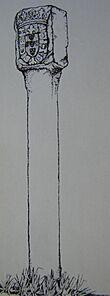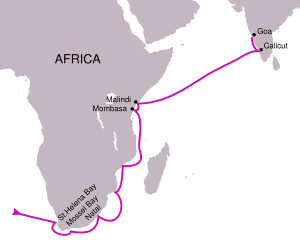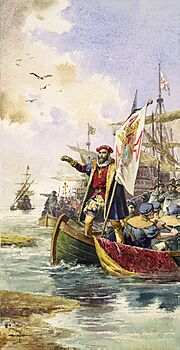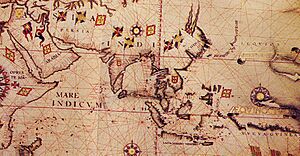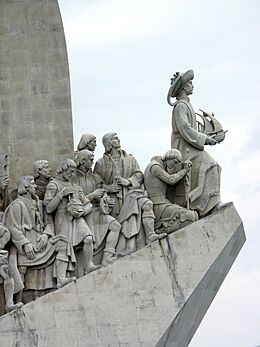Portuguese maritime exploration facts for kids
Portuguese maritime exploration led to the discovery of many lands and sea routes by Portuguese sailors in the 15th and 16th centuries. These brave explorers were leaders in European exploration. They mapped the coasts of Africa and Asia, then called the East Indies. They also explored parts of Canada and Brazil, known as the West Indies. This period is now known as the Age of Discovery.
Their planned journeys began in 1419 along the coast of West Africa. Prince Henry the Navigator supported these trips. In 1488, Bartolomeu Dias sailed around the Cape of Good Hope into the Indian Ocean. Ten years later, in 1498, Vasco da Gama led the first fleet around Africa to Calicut in India. This opened a new sea route from Portugal to India. Portuguese explorers then traveled to Southeast Asia, reaching Japan in 1542. In 1500, the Portuguese nobleman Pedro Álvares Cabral was the first European to discover Brazil.
Contents
How Portuguese Exploration Began
Early Trade and Sea Power
In 1297, King Dinis of Portugal became very interested in growing Portugal's trade. He helped export extra goods to other European countries. In 1293, he created a special fund to help Portuguese traders. This fund was like insurance for their ships and goods.
Portugal sold wine and dried fruits from Algarve to places like Flanders and England. Salt from Setúbal and Aveiro was also a valuable export. Portugal bought armor, fine clothes, and other products from Flanders and Italy.
In 1317, King Dinis made a deal with a Genoese sailor named Manuel Pessanha. He made Pessanha the first Admiral of Portugal. In return, Pessanha provided twenty warships and crews. This helped protect Portugal from pirate attacks. It also started the Portuguese Navy and brought Genoese traders to Portugal. These traders helped Portugal with their business and money skills.
Challenges and New Opportunities
In the late 1300s, the bubonic plague caused many deaths. This meant fewer people lived in towns, and farms were left empty. Many people moved to the coast to become fishers or traders.
Between 1325 and 1357, King Afonso IV of Portugal used public money to build a strong trading fleet. He also ordered the first sea explorations. In 1341, the Canary Islands were officially rediscovered by the Portuguese. However, Castile (part of Spain) also claimed them. This encouraged Portugal to explore even more. The first people taken as slaves by the Portuguese and Spanish were the Guanches from the Canary Islands.
Exploring the Atlantic Ocean (1418–1488)
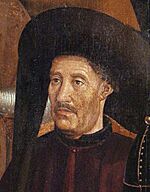
In 1415, Portugal took control of Ceuta, a city in North Africa. This gave them a base in Morocco and helped them control shipping. They also wanted to spread Christianity and gain wealth. Young Prince Henry the Navigator was part of this action.
Henry became the head of the Order of Christ in 1420. He also had profitable business deals in Algarve. He played a key role in encouraging Portuguese sea exploration until he died in 1460. He invested in voyages down the coast of Mauritania. He brought together merchants and shipowners who wanted new trade chances. Later, his brother, Prince Pedro, gave him a special right to all profits from trade in newly discovered areas.
In 1418, two of Henry's captains, João Gonçalves Zarco and Tristão Vaz Teixeira, were blown by a storm to Porto Santo. This was an empty island off the coast of Africa. In 1419, Zarco and Teixeira landed on Madeira. Portuguese people began to settle these islands. They grew wheat and later sugarcane, which became very profitable. This made both the settlers and Prince Henry richer.
The Portuguese tried to capture Grand Canary, one of the nearby Canary Islands. Spaniards had already settled parts of it. The Portuguese attempt failed and led to protests from Castile. Around 1427, Portuguese ships likely discovered the Azores under Henry's guidance. Settlers arrived in 1432. This showed that the Portuguese could sail far from their coast.
At the same time, the Portuguese started exploring the North African coast. Sailors were afraid of what lay beyond Cape Bojador. Europeans did not know what was there, or if they could return once they passed it. Henry wanted to know how far Muslim lands stretched in Africa. He also hoped to find the source of the valuable gold trade. He even dreamed of finding the lost Christian kingdom of Prester John.
In 1434, Gil Eanes, one of Prince Henry's captains, finally passed Cape Bojador. Once this fear was overcome, it became easier to explore further. Within 20 years, Portuguese ships had sailed past the Sahara desert.
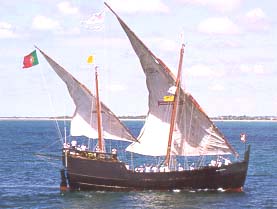
Henry faced a big problem in 1437. An expedition to capture Tangier failed. The Portuguese army was defeated. They only escaped by giving up Prince Ferdinand, the king's youngest brother. After this defeat, Henry moved to Sagres in southern Portugal. He continued to guide Portuguese exploration until he died in 1460.
In 1443, Prince Pedro, Henry's brother, gave him the sole right to navigation, war, and trade in lands south of Cape Bojador. Later, the Pope supported this right with special orders. These orders gave Portugal a trade monopoly in newly discovered lands.
The caravel was a type of ship used for exploration from about 1440. It had many good features. It could sail in shallow water, which was good for unknown coasts. It also had a special hull shape and sails that made it fast. This ship could sail better against the wind than other ships of that time.
Portuguese sailors kept reaching further south. They explored about one degree of latitude each year. They reached Senegal and Cape Verde Peninsula in 1445. That same year, the first overseas trading post was set up by Henry. It was on the island of Arguin off the coast of Mauritania. This post was meant to attract Muslim traders and control trade routes. By the 1460s, they reached the Gulf of Guinea.
Exploration After Prince Henry
Because the early African explorations didn't bring much wealth, King Afonso V gave a merchant named Fernão Gomes the right to trade in part of the Gulf of Guinea in 1469. Gomes had to pay a yearly fee. He also had to explore 100 leagues (about 550 km) of coast each year. He hired explorers like João de Santarém and Pedro Escobar. They explored more than required. Under Gomes, Portuguese explorers crossed the equator into the Southern Hemisphere. They found islands in the Gulf of Guinea, including São Tomé and Príncipe.
In 1471, Gomes's explorers reached Elmina on the Gold Coast (now Ghana). They found a busy gold trade happening there. Gomes set up his own trading post, called "A Mina" ("The Mine"). Trade between Elmina and Portugal grew. In 1481, the new king, João II, decided to build São Jorge da Mina fort (Elmina Castle). This fort protected the trade, which was now a royal monopoly.
In 1482, Diogo Cão discovered the mouth of the Congo River. In 1486, Cão continued to Cape Cross in modern-day Namibia. This was near the Tropic of Capricorn.
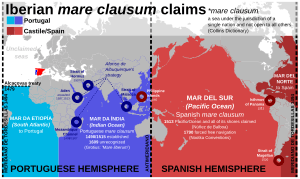
In 1488, Bartolomeu Dias sailed around the Cape of Good Hope. This proved that the Indian Ocean was connected to the Atlantic. Also around this time, Pêro da Covilhã reached India by traveling through Egypt and Yemen. He also visited Madagascar. He suggested more exploration of the southern sea route.
As the Portuguese explored Africa's coasts, they left stone crosses called padrões. These crosses had the Portuguese coat of arms and marked their claims. They also built forts and trading posts. From these bases, the Portuguese made money from the slave and gold trades. Portugal had almost complete control of the Atlantic slave trade for over 100 years. They exported about 800 slaves each year. Most were brought to Lisbon, where black Africans made up about 10 percent of the population.
Dividing the World (1492)

In 1492, Christopher Columbus discovered the New World for Spain. He thought it was Asia. This led to arguments between Spain and Portugal. They settled these arguments with the Treaty of Tordesillas in 1494. This treaty divided the world outside Europe between Portugal and Spain. The dividing line was a north-south line 370 leagues (about 1,770 km) west of the Cape Verde islands. However, it was hard to measure longitude accurately back then. So, the exact border was debated until 1777.
This agreement with Spain is one reason historians think it took nine years for Portugal to follow up on Dias's voyage. Some also believe other secret voyages were happening during this time. Either way, Portugal's long-term goal of finding a sea route to Asia was finally achieved by Vasco da Gama.
Reaching India and Brazil (1497–1500)
Vasco da Gama's fleet left Portugal on July 8, 1497. It had four ships and 170 men. They sailed around the Cape and along the coast of Southeast Africa. There, a local pilot guided them across the Indian Ocean. They reached Calicut in western India in May 1498. After some problems, da Gama got a letter for trade with the ruler of Calicut. He left some men there to set up a trading post.
Vasco da Gama's trip to Calicut started the building of Portuguese trading posts along East Africa and in the Indian Ocean. Soon after, the Casa da Índia was set up in Lisbon. This office managed the king's control over sea travel and trade. Exploration then became mainly supported by the Portuguese Crown, not private groups.
The second voyage to India was sent in 1500 under Pedro Álvares Cabral. Cabral followed the same route across the Atlantic as da Gama. This route used the best winds. Cabral landed on the Brazilian coast. This was probably an accident. But some think the Portuguese secretly knew about Brazil and that it was on their side of the Tordesillas line. Cabral told the Portuguese King that the land should be settled. Two more voyages were sent in 1501 and 1503. The land had a lot of pau-brasil, or brazilwood, which gave Brazil its name. But they didn't find gold or silver. So, Portugal focused its efforts on India for a while.
Exploring the Indian Ocean (1497–1542)
Portugal's goal in the Indian Ocean was to control the spice trade. They used rivalries between Hindus and Muslims to their advantage. The Portuguese built several forts and trading posts between 1500 and 1510. In East Africa, small Islamic states along the coast were either destroyed or became allies of Portugal. Pêro da Covilhã had reached Ethiopia as early as 1490. A diplomatic group reached the Ethiopian ruler in 1520.
In 1500, the second fleet to India (which also landed in Brazil) explored the East African coast. Diogo Dias discovered an island he named St. Lawrence, now known as Madagascar. This fleet, led by Pedro Álvares Cabral, arrived in Calicut in September. The first trade agreement in India was signed there. A Portuguese trading post was set up, but it was attacked by Muslims. Several Portuguese, including Pêro Vaz de Caminha, died. Cabral then bombed Calicut and went to the rival city of Kochi.
The Portuguese were welcomed in Kochi because of the rivalry between the Maharaja of Kochi and the ruler of Calicut. They were seen as allies. They got permission to build a fort (Fort Manuel) and a trading post. This was the first European settlement in India. In 1503, they built the St. Francis Church there. In 1502, Vasco da Gama took the island of Kilwa on the coast of Tanzania. In 1505, the first Portuguese fort in East Africa was built there to protect ships.
In 1505, King Manuel I of Portugal appointed Francisco de Almeida as the first Viceroy of Portuguese India. This started Portuguese rule in the east, based in Kochi. That year, the Portuguese conquered Kannur and built St. Angelo Fort. The Viceroy's son, Lourenço de Almeida, arrived in Ceylon (modern Sri Lanka). He found the source of cinnamon there. He made a defense deal with a local kingdom and gained control of coastal areas. In 1517, the fortress of Colombo was founded.
In 1506, a Portuguese fleet led by Tristão da Cunha and Afonso de Albuquerque conquered Socotra at the entrance of the Red Sea. They also took Muscat in 1507. They tried to close these entrances to the Indian Ocean. That same year, forts were built on the Island of Mozambique and in Mombasa, Kenya. Madagascar was partly explored, and Mauritius was discovered.
In 1509, the Portuguese won the Battle of Diu at sea. They fought against a large group of forces, including the Ottoman Sultan and the Sultan of Gujarat. This victory was very important for Portugal's control of the Indian Ocean. The Turks and Egyptians pulled their navies from India. This left the seas to the Portuguese, who controlled trade for almost a century. It also marked the start of European colonial power in Asia. A second Battle of Diu in 1538 finally ended Ottoman hopes in India.
Under Albuquerque's rule, Goa was taken from the Bijapur sultanate in 1510. This was done with help from a Hindu privateer named Timoji. Goa was the best port in the region, especially for trading Arabian horses. It became the center of Portuguese government, called Estado da India (State of India). Neighboring kingdoms sent representatives, offering alliances. Albuquerque also started the first Portuguese mint in India in Goa.
Southeast Asia Expeditions
In April 1511, Albuquerque sailed to Malacca in modern-day Malaysia. This was a very important trading hub in the east. Traders from many different places met there. Malacca became a key base for Portuguese trade with China and Southeast Asia. A strong fort called "A Famosa" was built to defend the city.
Albuquerque learned that Siam (modern Thailand) wanted Malacca. So, he immediately sent Duarte Fernandes on a diplomatic trip to the kingdom of Siam. He was the first European to arrive there. This started friendly relations between the two kingdoms. In November that year, Albuquerque sent an expedition to find the "Spice Islands" in the Moluccas. Led by António de Abreu, the expedition arrived in early 1512. Francisco Serrão went to Ternate, where a Portuguese fort was allowed. That same year, in Indonesia, the Portuguese took Makassar, reaching Timor in 1514.
From Malacca, Jorge Álvares reached southern China in 1513. Trade was set up in Guangzhou. Later, a trading post was established at Macau.
The Portuguese empire also grew into the Persian Gulf. Portugal fought with the Ottoman Empire for control of the spice trade. In 1515, Afonso de Albuquerque conquered Ormuz at the head of the Persian Gulf. He made it a vassal state. However, Aden resisted Albuquerque's attack that same year. Portugal controlled much of the southern Persian Gulf for the next 100 years. The island of Mozambique became an important port on the route from Lisbon to Goa. A fort and a hospital were built there.
In 1525, after Fernão de Magalhães's expedition (1519–1522), Spain sent an expedition to colonize the Moluccas islands. Spain claimed these islands were in their part of the Treaty of Tordesillas. This led to conflicts with the Portuguese already in Ternate. They fought for almost a decade. An agreement was finally reached with the Treaty of Zaragoza (1529). This treaty gave the Moluccas to Portugal and the Philippines to Spain.
In 1530, John III started to colonize Brazil. He divided it into 15 "hereditary captainships." These were given to people who wanted to manage and explore them. This was to help defend the land, as the French were making incursions. That same year, Martim Afonso de Sousa led a new expedition. He was ordered to patrol the Brazilian coast, remove the French, and create the first colonial towns. Only two of the original captainships, Pernambuco and São Vicente, did well. With permanent settlements came the sugar cane industry. This needed a lot of workers, so Native American and later African slaves were used.
In 1534, Gujarat was taken by the Mughals. The Sultan of Gujarat had to sign a treaty with the Portuguese. This treaty formed an alliance to regain the country. In return, Portugal received Daman, Diu, Mumbai, and Bassein. In 1538, the fort of Diu was again surrounded by Ottoman ships. Another siege failed in 1547. This ended Ottoman hopes and confirmed Portugal's power.
In 1542, Jesuit missionary Francis Xavier arrived in Goa. He was sent by King John III of Portugal. At the same time, Francisco Zeimoto, António Mota, and other traders arrived in Japan for the first time. According to Fernão Mendes Pinto, who claimed to be on this journey, they arrived at Tanegashima. The locals were very impressed by European firearms. The Japanese quickly started making them on a large scale.
In 1557, Chinese authorities allowed the Portuguese to settle in Macau. They paid a yearly fee. This created a trading hub between China, Japan, and Europe. In 1570, the Portuguese bought a Japanese port. They founded the city of Nagasaki there. This became a major trading center for Japan.
Portugal set up trading ports in many distant places. These included Goa, Ormuz, Malacca, Kochi, the Maluku Islands, Macau, and Nagasaki. Portugal protected its trade from both European and Asian rivals. They controlled not only trade between Asia and Europe but also much of the trade within Asia. Jesuit missionaries, like Francis Xavier, followed the Portuguese. They aimed to spread Christianity in Asia, with some success.
Mapping the World: Portuguese Discoveries (1415–1543)

Key Moments in Portuguese Exploration
- 1415: Portugal conquers Ceuta in North Africa.
- 1419: João Gonçalves Zarco and Tristão Vaz Teixeira discover Porto Santo island in the Madeira group.
- 1420: The same sailors discover the island of Madeira, which is soon settled.
- 1427: Diogo de Silves discovers the Azores.
- 1434: Gil Eanes sails around Cape Bojador, a major barrier.
- 1443: Prince Pedro gives Henry the Navigator control over navigation and trade south of Cape Bojador.
- 1444: Dinis Dias reaches Cape Green (Cabo Verde).
- 1455: The Pope confirms Portugal's control over lands and waters south of Cape Bojador.
- 1456: Luis Cadamosto discovers the first Cape Verde Islands.
- 1460: Death of Prince Henry the Navigator.
- 1471: João de Santarém and Pedro Escobar cross the Equator. They discover the islands of São Tomé and Príncipe.
- 1479: The Treaty of Alcáçovas gives Portugal control of the Azores, Guinea, Elmina, Madeira, and Cape Verde Islands.
- 1482: Diogo Cão reaches the mouth of the Congo River.
- 1487: Afonso de Paiva and Pero da Covilhã travel overland to find the Kingdom of Prester John (Ethiopia).
- 1488: Bartolomeu Dias sails around the Cape of Good Hope, entering the Indian Ocean.
- 1494: The Treaty of Tordesillas divides the world between Portugal and Spain.
- 1498: Vasco da Gama leads the first fleet around Africa to Calicut, India.
- 1500: Pedro Álvares Cabral discovers Brazil on his way to India.
- 1500: Diogo Dias discovers Madagascar.
- 1505: Lourenço de Almeida makes the first Portuguese voyage to Ceylon (Sri Lanka).
- 1509: The Portuguese win the Battle of Diu, securing control of the Indian Ocean.
- 1511: Afonso de Albuquerque conquers Malacca, a major trading hub.
- 1512: António de Abreu discovers Timor island and reaches the Banda Islands. Francisco Serrão reaches the Moluccas.
- 1513: The first European trading ship, under Jorge Álvares, reaches the coasts of China.
- 1525: Diogo da Rocha and Gomes de Sequeira reach Celebes and possibly other Pacific islands.
- 1526: Jorge de Meneses discovers New Guinea.
- 1529: The Treaty of Zaragoza (1529) divides the eastern hemisphere between Spain and Portugal.
- 1542–43: Fernão Mendes Pinto, António Mota, and Francisco Zeimoto reach Japan.
- 1557: Macau is given to Portugal by the Emperor of China.
- 1570: The Portuguese buy a Japanese port and found the city of Nagasaki.


